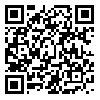Volume 4, Issue 4 (October 2020)
AOH 2020, 4(4): 842-848 |
Back to browse issues page
Download citation:
BibTeX | RIS | EndNote | Medlars | ProCite | Reference Manager | RefWorks
Send citation to:



BibTeX | RIS | EndNote | Medlars | ProCite | Reference Manager | RefWorks
Send citation to:
Mohammadi H, Heidari H, Arsang Jang S, Ghafourian M, Soltanzadeh A. Relationship between Reactive and proactive Safety Indices: A Case Study in the Chemical Industries. AOH 2020; 4 (4) :842-848
URL: http://aoh.ssu.ac.ir/article-1-159-en.html
URL: http://aoh.ssu.ac.ir/article-1-159-en.html
Heidar Mohammadi1 

 , Hamidreza Heidari2
, Hamidreza Heidari2 

 , Shahram Arsang Jang3
, Shahram Arsang Jang3 

 , Mona Ghafourian4
, Mona Ghafourian4 

 , Ahmad Soltanzadeh *5
, Ahmad Soltanzadeh *5 




 , Hamidreza Heidari2
, Hamidreza Heidari2 

 , Shahram Arsang Jang3
, Shahram Arsang Jang3 

 , Mona Ghafourian4
, Mona Ghafourian4 

 , Ahmad Soltanzadeh *5
, Ahmad Soltanzadeh *5 


1- Department of Occupational Safety & Health Engineering, Faculty of Health, Larestan University of Medical Sciences, Fars, Iran
2- Department of Occupational Safety & Health Engineering, Faculty of Health, Research Center for Environmental Pollutants, Qom University of Medical Sciences, Qom, Iran
3- Department of Biostatistics & Epidemiology, Faculty of Medicine, Zanjan University of Medical Sciences, Zanjan, Iran
4- Department of Occupational Health Engineering, Shahr-e-Rey Health and Medical Network, Tehran University of Medical Sciences, Tehran, Iran
5- Department of Occupational Safety & Health Engineering, Faculty of Health, Research Center for Environmental Pollutants, Qom University of Medical Sciences, Qom, Iran ,soltanzadeh.ahmad@gmail.com
2- Department of Occupational Safety & Health Engineering, Faculty of Health, Research Center for Environmental Pollutants, Qom University of Medical Sciences, Qom, Iran
3- Department of Biostatistics & Epidemiology, Faculty of Medicine, Zanjan University of Medical Sciences, Zanjan, Iran
4- Department of Occupational Health Engineering, Shahr-e-Rey Health and Medical Network, Tehran University of Medical Sciences, Tehran, Iran
5- Department of Occupational Safety & Health Engineering, Faculty of Health, Research Center for Environmental Pollutants, Qom University of Medical Sciences, Qom, Iran ,
Abstract: (2004 Views)
Background: Investigating the influence of various proactive factors on reactive indices in the chemical industries can result in providing preventive and control measures in these industries. This study was designed and conducted to measure the relationship between reactive and proactive safety indices in the chemical industry. Methods: This cross-sectional study was conducted in 2018 in 12 chemical industries. The study data were associated with a period of 5 years (2013-2017). Study data has been analyzed based on factor analysis using analytical software IBM SPSS AMOS v. 22.0. χ2 / df, RMSEA, CFI, NFI, and NNFA (TLI) indices were used to evaluate the model's goodness fit in this study. Results: The mean reactive indices of recurrence coefficient and accident severity in this study was 14.15(18.32) and 182.112(10.50) days, respectively. The exploratory factor analysis results determined that 16 indicator variables were categorized into 4 groups of proactive indices, including safety training, risk management, control of unsafe situations, and unsafe acts. Analyzing the confirmatory factor additionally confirmed that there is a significant relationship between the two groups of reactive and proactive indices in this study(P <0.05), and the goodness of model fit was also recognized appropriate (RMSEA = 0.055). Conclusion: This study's findings approved that the proactive indices affect the incidence and severity of accidents as safety reactive indices in the chemical industries. Also, the risk management proactive index and insecurity conditions were more effective than other indices.
Type of Study: Research |
Subject:
Special
Received: 2019/01/26 | Accepted: 2020/10/11 | Published: 2020/10/11
Received: 2019/01/26 | Accepted: 2020/10/11 | Published: 2020/10/11
Send email to the article author
| Rights and permissions | |
 |
This work is licensed under a Creative Commons Attribution-NonCommercial 4.0 International License. |




